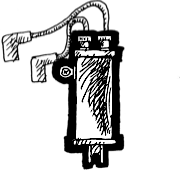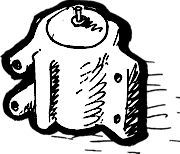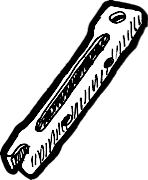Ignition Coils and Brackets
Ignition coils: where the voltage for the spark plugs is generated
The ignition coil is effectively the "switching center" between the low-voltage and high-voltage areas of the ignition. By low voltage, we mean the 6 or 12 volts that flow from the battery through the primary windings of the ignition coil to the breaker contacts or the control unit. The high voltage part, we mean the spark plugs, the ignition wires and terminals, and the secondary windings in the ignition coil. The ignition coil is constructed like a transformer. But we will spare you the complete lecture about Rühmkorff's induction coil now and summarize this briefly: low voltage (6 or 12 V) flows through the primary windings of the ignition coil and builds up a magnetic field. When this current flow is interrupted, the collapse of the magnetic field in the secondary windings of the coil creates a high voltage. (The magnetic field tries to sustain itself.) We harness the high voltage at the spark plugs for a spark.
How is an ignition coil constructed?
Each ignition coil has a housing, formerly made of sheet steel, but nowadays only made of plastic. Each ignition coil contains insulation material, once tar or bitumen, nowadays plastic. In some coils from Andrews or DynaTec, the manufacturer saves the separate housing and the plastic mass is also the shaping element. Each ignition coil also contains two solenoid coils, once the so-called primary coil with a few turns of strong wire and the secondary coil with thousands of turns of very fine wire. Each ignition coil also contains a coil core made of iron sheets. This strengthens the magnetic field.
The wire windings of the coils are a potential problem area. They are, of course, not made of "coiled electrical wire" but of enameled wire. If an ignition coil gets too hot during operation, the enamel insulation of the wire can be damaged. Then the current jumps across one or more turns and the solenoid no longer works.
What is the difference between ignition coils? What do I have to consider when choosing? Can I use any coil?
Apart from shape and color and manufacturer - of course, you can also choose an ignition coil according to this - each coil has a so-called primary resistance. We also indicate this in the store with the articles: Just click on "Facts". This primary resistor determines how much current flows through this coil and the breaker contacts or the black box. These parts are connected one after the other ("in series", says the electrician). This current is important for the life of the black box and the breaker contacts. Too much current also generates too much heat in the ignition coil. Then we're back to the problem of paint insulation.
Ignition coils then differ in the shape of their mounting bracket. Some come with it, but most still need a bracket on the bike. Important things like the number and placement of the mounting holes and the outer dimensions of the coils can be found in the store on drawings in the visuals for the ignition coils.

Have any questions?
Our service team will be glad to help out: Mondays - Thursdays 08:00-17:00 CET, Fridays 08:00-16:00 CET, Phone: +49 / 931 250 61 16, eMail: service@wwag.com


